Mastering the Art of Window Selection for Australian Homes
With Phillip’s expert guidance, this comprehensive guide will further elaborate on the types of windows available in Australia, critical considerations during selection, additional window features, maintenance tips, and answers to some frequently asked questions. Let’s illuminate your perfect window choice!

Understanding the Importance of Window Selection
Windows play a vital role in the overall ambiance and functionality of your home. They let in natural light, provide ventilation, insulate against weather extremes, and act as a sound barrier. Furthermore, the style and design of windows contribute significantly to the aesthetic appeal of your home, both internally and externally. As such, selecting the right window type is more than just an architectural decision; it’s about optimizing the comfort and value of your home.
Critical Factors to Selecting the Right Window
Knowing window types is the first step. Next, consider the following factors to narrow down your choices:
Energy Efficiency: High-performing windows reduce energy costs and increase comfort. Look for features like double glazing, low-E coatings, and argon-filled spaces for superior insulation.
Material: Window materials affect aesthetics, durability, maintenance, and thermal performance. Popular options include wood, vinyl, aluminum, and fiberglass.
Style and Design: Choose a window style that enhances your home’s architectural theme. Consider the proportion, arrangement, and decorative elements.
Installation and Maintenance: A professional installation ensures optimal window performance. Understand the maintenance requirements to keep your windows in good shape.
Cost: Window prices vary based on size, material, type, and additional features. Prioritize your needs and preferences to find the best value for your budget.
A Guide to Popular Window Types in Australia
In the Australian market, the range of window types caters to diverse architectural styles and practical needs. Here’s a closer look at nine common varieties:
Casement Windows
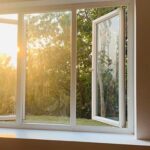
Attached to the frame by one or more hinges, casement windows open outwards, much like a door. They offer excellent ventilation and unobstructed views and are easy to clean from the inside, ideal for hard-to-reach places.
Sash Windows
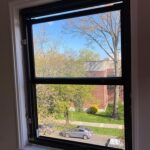
These are composed of one or two movable panels or ‘sashes.’ Double-hung models allow both sashes to slide vertically for versatile ventilation, while single-hung variants have a fixed top sash. They are perfect for maintaining a classic look in period homes.
Sliding Windows
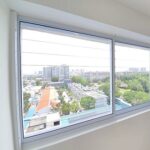
Sliding windows move along a horizontal track. With fewer moving parts, they’re reliable, offer wide views, and are easy to operate, ideal for spaces overlooking gardens or patios.
Bay & Bow Windows

These project outward from the home, adding an interesting architectural element. They capture panoramic views and invite more natural light in, providing a spacious feel.
Awning Windows
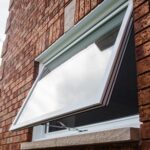
Hinged at the top and opening outwards, awning windows can remain open during light rain, providing continuous ventilation. Their design also contributes to home security as they’re hard to climb into from outside.
Hopper Windows
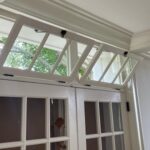
These open inwards and are hinged at the bottom, making them perfect for tight spaces like basements while providing superior energy efficiency due to the tight seal created when closed.
Louvre Windows
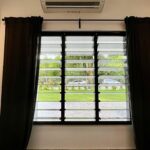
Comprising a series of horizontal slats, louvre windows can be precisely adjusted to control airflow. They’re ideal for spaces requiring regular ventilation like kitchens or bathrooms.
Storm Windows
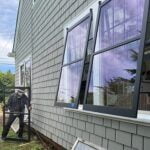
Installed in combination with existing windows, storm windows add an extra layer of insulation and weather protection, reducing energy costs, and enhancing soundproofing.
Skylight
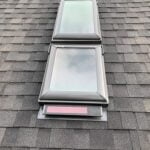
Installed in roofs, skylights bring in abundant natural light, ideal for darker rooms. They also add an element of luxury to a space.
Choosing the Right Window Material for Optimum Performance
The material used for your window frames can significantly impact durability, maintenance requirements, insulation, and aesthetic appeal. Let’s explore the most common options:
- Aluminium Frames: Aluminium window frames are a popular choice due to their durability and low maintenance. However, aluminium readily conducts heat, which leads to higher U-values – a measure of heat transfer. Higher U-values indicate that more heat is lost, which is not ideal for insulation.
- Thermally Broken Aluminium Frames: These frames offer an improvement over standard aluminium frames. They feature a less conductive material that separates the frame’s interior and exterior sections, reducing heat transfer. Do note that these are different from “thermally improved” frames, which still have higher U-values compared to other materials.
- Timber Frames: Known for their excellent thermal performance, timber frames are a classic option that adds a warm aesthetic appeal to any home. However, one downside is that they may allow greater air infiltration, which can affect energy efficiency.
- uPVC Frames: Made from rigid PVC, uPVC (un-plasticised polyvinyl chloride) frames offer similar thermal performance to timber frames. They’re also highly durable and require low maintenance.
- Fibreglass Frames: Composed of glass-reinforced polyester, fibreglass frames provide impressive thermal performance on par with timber frames. These frames are also highly durable and resistant to warping, expanding, or contracting with temperature changes.
- Composite Frames: These frames blend the best of multiple materials. The exterior section is made from a durable material like aluminium or uPVC, while the interior section features a decorative material like timber. This combination offers a balance of performance, maintenance, and aesthetic appeal.
The choice of window frame material depends on your specific needs, including the level of insulation required, the climate in your area, maintenance preferences, and the look you want to achieve. Consulting with a professional can provide personalized advice based on your home’s unique needs.
The Importance of Choosing the Right Glass Type
The type of glass used in your windows plays a crucial role in energy efficiency, security, noise control, and even aesthetics. Choices range from clear and tinted to reflective and Low-E glass.
You can check out our article about all the different type of glass options available for more info.
Understanding the Importance of Energy Efficiency
Energy-efficient windows can significantly reduce your heating and cooling costs. Look for windows with a high WERS (Window Energy Rating Scheme) rating for the best energy efficiency.
Additional Window Features
Look beyond basic functionalities. Modern windows offer added benefits that could make a significant difference:
Soundproofing: If you live in a noisy area, consider acoustic windows. Special laminates like those used in acoustic glass and gases between glazing layers can drastically reduce noise transmission.
Security: Consider toughened or laminated glass and secure locking mechanisms to enhance your home’s security.
Customization: Many manufacturers offer customization options, including unique finishes, colors, and hardware styles, to complement your home décor.
Caring For Your Windows
Your windows’ longevity significantly depends on how well they’re cared for:
- Clean windows regularly using appropriate cleaning solutions.
- Inspect for damage or wear, like chipped paint or gaps in sealing. Check out our article about the reasons windows leak for more info.
- Repair any damage promptly to prevent it from escalating.
- Use professional window cleaning and maintenance services for best results.
FAQ
Fiberglass and vinyl are generally considered the most energy-efficient window materials due to their excellent insulation properties and low thermal conductivity.
The lifespan of windows can vary depending on factors such as material, quality, and maintenance. On average, windows should be replaced every 15-20 years, but some high-quality windows may last longer with proper care.
While DIY window installation is possible, it is generally not recommended. Improper installation can result in decreased energy efficiency, increased air infiltration, and potential damage to your home. It is best to hire a professional installer for optimal results.
If your windows are drafty, hard to operate, or visibly deteriorated, it’s likely time for a replacement. Increased energy bills could also be a hint as old, inefficient windows could be causing heat gain or loss.

Khalil is the owner of Splendid Window Glass Repairs and has over 8 years experience as a glazier specialising in window glass repair, replacement and installations. Khalil takes great pride in his work and prides himself on providing an excellent service to all of his customers, no matter how big or small the job may be.
